Kum Kale to Nazareth: Rudolf Schierholz
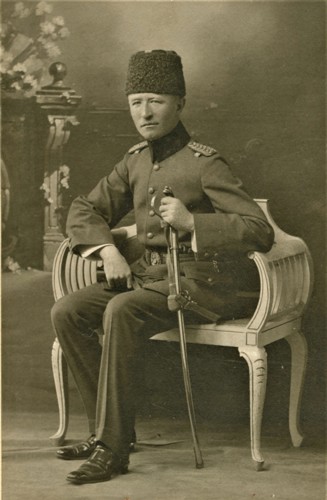
Rudolf Schierholz (credit: Gunter Hartnagel, with permission).
Kum Kale to Nazareth
Rudolf Schierholz
21.5.1874 – 8.12.1917
by
Michael D. Robson
Just ten days after his 21st birthday Rudolf Schierholz became a Portepeefähnrich (Ensign) in the 8th Company, 107th Infantry Regiment of the Saxon army, and only eight months later he was promoted to Leutnant on 21st January 1896. Further promotions carried him to Oberleutnant in 1903, and Hauptmann in 1910. Later he was reassigned to the 182nd Infantry Regiment which was first formed in 1912.
In February 1914 Hauptmann Schierholz transferred to the reserves, but the next month he was appointed to the German Military Mission under General Otto Liman von Sanders, who had been in Istanbul since December 1913.
Turkish records show that Schierholz became an instructor at an infantry staff officer school. At the outbreak of hostilities he was given the Ottoman rank of Kaimakam (Lieutenant Colonel)¹ and appointed to command one of the 3rd Division's infantry regiments. The 9th. I.R. were responsible for coastal protection with the Menderes Western Force. When the 9th I.R. was reassigned to another command however, Schierholz was not sent with them, but reverted to a staff appointment and remained with the forces overseeing the defence of the Asian side of the entrance to the Dardanelles.²
The French made their diversionary landing at Kum Kale on 25th April 1915, under the protective fire of the allied fleet's Sixth Squadron commanded by Rear Admiral P.F.A.H. Guépratte.³
The landing by the 6th Colonial Regiment was fiercely opposed and the defending Ottoman forces suffered heavy casualties. By nightfall nearly all of the officers of the 39th Infantry Regiment were hors de combat and at this point Schierholz was given command of that regiment's remnants who were formed into a provisional detachment.
General Eric Paul Weber Paşa commanded the Ottoman XV Corps, and under him, Major General August Nicholai Paşa the 3rd Division of which the 39th I.R. was a part. Nicholai was not only Schierholz's immediate superior, but like him he too was a Saxon, and it seems probable that it was he who made the recommendation for Schierholz’s brave actions to be officially recognised.
The citation for the award of the Knight's Cross of the Saxon Militär-St. Heinrichs-Orden⁴ translates as follows:
In the fighting for the Dardanelles, Hptm. Schierholz was the first officer to set foot in the recaptured Kum Kale after French troops had attempted to land on April 25, 1915. Immediately after the battle, for 1 day and 2 nights in the burning village and under heavy enemy shell fire, he personally supervised the retrieval of all the wounded. Because he, as the independent detachment commander of the coastal defences of the 3rd Ottoman Division, opposed the landing attempts of two enemy reconnaissance detachments, he saved the Asian shore from further attacks. He then spent months on the Gallipoli Peninsula monitoring the establishment of defensive positions on one flank near Anafarta under constant enemy fire. In all these combat actions, he distinguished himself by outstanding gallantry and boldness.
After Gallipoli, in 1916 Schierholz commanded the Ottoman 146th Infantry Regiment at Serres (Serrai) on the Macedonian front. There he was joined by Mulazim-i-sani (2nd Lt.) Moshe Shertok who served as his interpreter.⁵
In 1917 Schierholz was transferred (with 146th Inf. Regt., and interpreter Shertok) to the Palestine theatre and was based at Ma'an from 1st August 1917. There he was responsible for the protection of the Hedjaz railway against Bedouin insurgents.⁶
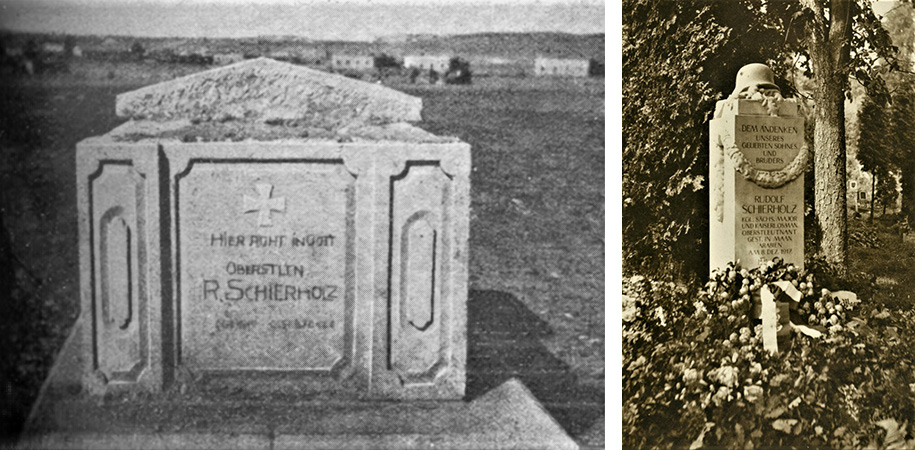 Left: Schierholz’s original tomb in Ma’an (credit: from German veterans’ magazine ‘Mittelungen des Bundes der Asienkämpfer’). Right: Schierholz’s memorial in Roda, today Stadroda (credit: Gunter Hartnagel, with permission).
Left: Schierholz’s original tomb in Ma’an (credit: from German veterans’ magazine ‘Mittelungen des Bundes der Asienkämpfer’). Right: Schierholz’s memorial in Roda, today Stadroda (credit: Gunter Hartnagel, with permission).
On December 8, 1917, Rudolf Schierholz died of dysentery (Ruhr) and was buried at Ma'an (today in the Kingdom of Jordan) in a stone tomb.⁷ A memorial stone was erected in his home-town of Roda (today Stadtroda) in 1918, and in 1932 he found his final resting place when his remains were transferred to the German War Cemetery in Nazareth.
In October 2022 the Gallipoli Association were pleased to recognise Rudolf Schierholz's part in the 1915 campaign when, on their behalf, Michael D. Robson placed a wreath on his grave in Nazareth.
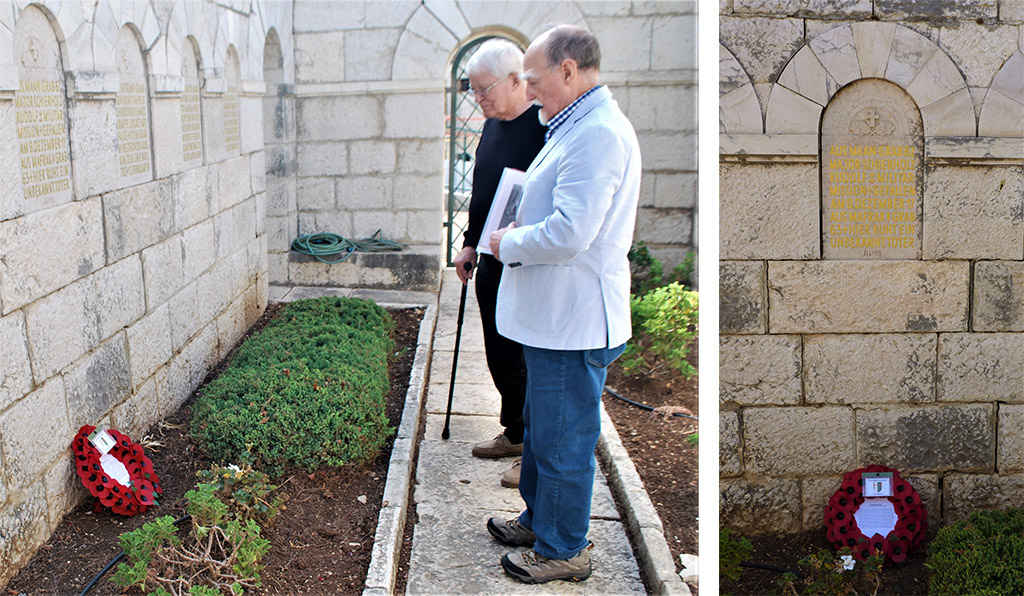
Left: Dr. Norbert Schwake & Michael D. Robson at Schierholz’s grave (credit: photograph by Stuart Hadaway). Right: The Gallipoli Association's wreath on Schierholz’s grave (credit: photograph by Michael D. Robson).
Notes
¹ When on active service with the Ottoman armies, German officers were always granted one rank above their substantive rank. In this text these higher ranks are used from this point on.
² 'The Struggle for the Dardanelles – the memoirs of a German Staff Officer in Ottoman Service' by Dr. Philip Rance, page 225 –
In mid-December 1914 the three regiments of the 3rd Div. (including the 9th Regt.) were transferred to other fronts and the 3rd Div. reconstituted with replacement regiments: 31st, 32nd & 39th. Schierholz however did not move away from the Dardanelles with the 9th Regt., but remained in the Gallipoli theatre on the Staff of the newly reconstituted 3rd Div.
³ The Sixth Squadron comprised theJauréquiberry, Henri IV, Charlemagne, Jean D'Arc, Askold (Russian) and Savoie, plus seven destroyers and five torpedo boats. [At 08:00hrs on 25 April, the Jean D'Arc was withdrawn to join the demonstration at Bashika Bay, a few miles to the south.]
⁴ This was the oldest military order of all the states of the German Empire. The citation appears in Der Königlich Sächsische Militär-St. Heinrichs-Orden 1736–1918, by G. Richter, Frankfurt, 1964.
⁵ Moshe Shertok, who was awarded the Iron Cross, later changed his family name to Sharett, and went on to become the foreign minister and then prime minister of Israel. He died in 1965.
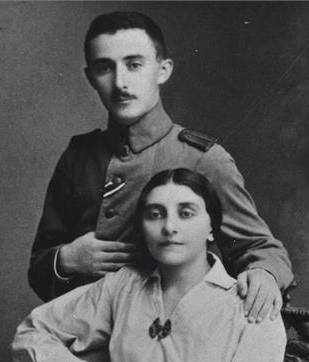
Moshe Shertok with his sister (credit: photograph from the Jewish Nation Fund Photographic Archive, public domain).
⁶ 'Palestine – the Ottoman Campaigns of 1914-1918' by Edward J. Erickson, page 92 –
“The loss of Aqaba to Lawrence and the Arabs on 6 July 1917 seriously damaged the Ottoman operational posture in the Arabian Peninsula by creating a direct threat to Ma'an. … … …
[it] forced Cemal (Ahmet Cemâl Paşa) and Fahrettin (Ömer Fahrettin Türkkan Paşa) to revise the Ottoman command architecture in lower Palestine.”
Erickson describes Ma'an as the northern terminus of the Medina railway and Fahrettin, who was commander of the Hejaz Expeditionary Force, was charged with the defence of Medina.
⁷ Upon opening the tomb at Ma'an it was found that robbers had broken into the coffin at the head end, nevertheless the body remained whole. The excavators however were shocked when they found a hand grenade between Schierholz's feet. [Photograph and details from 'Deutsche Soldatengräber in Israel' by Dr. Norbert Schwake.]
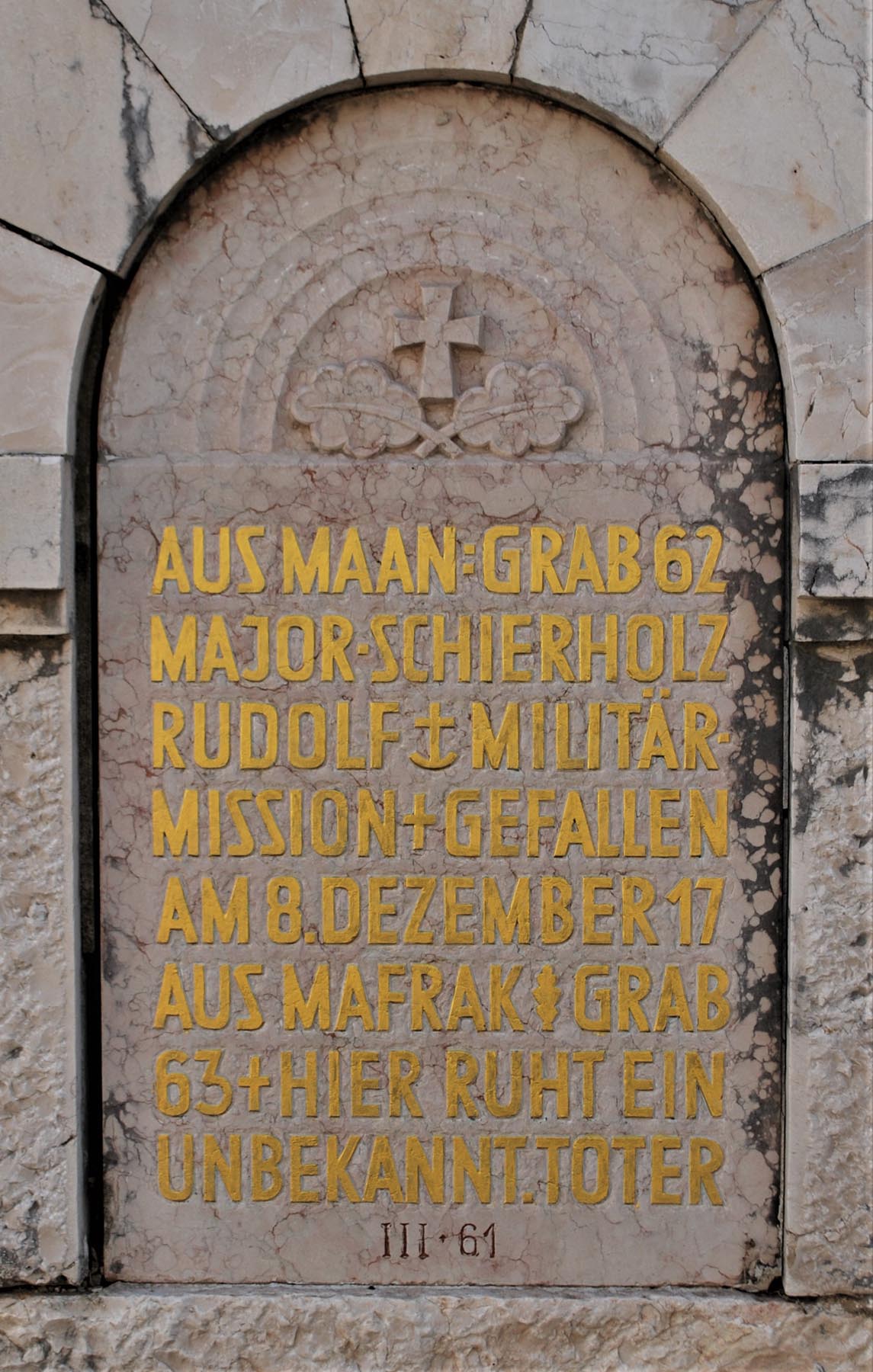
The head panel above Schierholz grave in Nazareth (credit: photograph by Stuart Hadaway).
